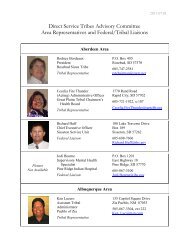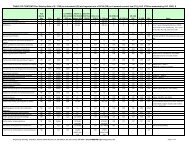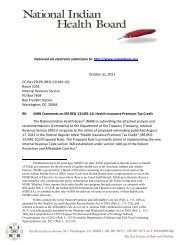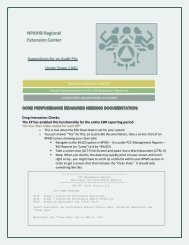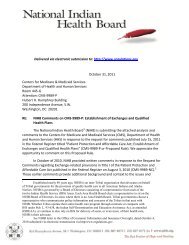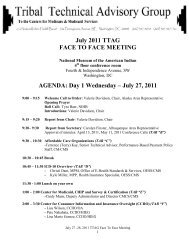mmpc - National Indian Health Board
mmpc - National Indian Health Board
mmpc - National Indian Health Board
You also want an ePaper? Increase the reach of your titles
YUMPU automatically turns print PDFs into web optimized ePapers that Google loves.
California Rural <strong>Indian</strong><br />
<strong>Health</strong> <strong>Board</strong><br />
September 21, 2012<br />
Valerie B. Jarrett, Senior Advisor<br />
The White House<br />
1600 Pennsylvania Avenue N.W.<br />
Washington, DC 20500<br />
Dear Ms. Jarrett and Ms. Gillette:<br />
Jodi Gillette, Senior Policy Advisor<br />
Native American Affairs<br />
1600 Pennsylvania Avenue N.W.<br />
Washington, DC 20500<br />
Northwest Portland Area<br />
<strong>Indian</strong> <strong>Health</strong> <strong>Board</strong><br />
The California Rural <strong>Indian</strong> <strong>Health</strong> <strong>Board</strong> (CRIHB) and the Northwest Portland Area <strong>Indian</strong> <strong>Health</strong> <strong>Board</strong><br />
(NPAIHB) are Tribal organizations organized under the <strong>Indian</strong> Self-Determination and Education Assistance<br />
Act. 1 Our organizations represent health care issues of 63 federally-recognized Tribes in California, Idaho,<br />
Oregon, and Washington. We are writing to you about a very important Affordable Care Act matter.<br />
In just three months, States will be applying to the federal government for certification of their <strong>Health</strong><br />
Insurance Exchanges under the Affordable Care Act. One of the current activities for both State Exchanges<br />
and the Federally-Facilitated Exchange is to create a single streamlined application for Medicaid, Child <strong>Health</strong><br />
Insurance Programs, and the individual Exchanges. The Administration’s goal of a short and simple application<br />
that uses electronic data bases is at odds with regulatory guidance regarding identifying American <strong>Indian</strong>s and<br />
Alaska Natives (AI/AN) for the purposes of cost sharing waivers, special enrollment periods, and other<br />
protections in Medicaid, CHIP and the Exchanges. It is imperative that the White House provide guidance on<br />
this issue so that AI/AN who were intended to benefit from ACA are not left out.<br />
Here is a short list of potential problems that could occur if the definition of <strong>Indian</strong> used by Exchanges is<br />
different from the one used by Medicaid and CHIP:<br />
An AI/AN child who is not allowed to enroll as tribal members until her 18 th birthday will not be<br />
considered as AI/AN by Exchanges, although she would be considered AI/AN by Medicaid and CHIP.<br />
An Alaska Native adult will not be considered AI/AN by Exchanges until his parent dies and he inherits<br />
stock in an Alaska Native corporation. And his children will not be considered AI/AN by Exchanges<br />
until he dies and his stock in an Alaska Native corporation is passed along to his children, even though<br />
they qualify as AI/AN under Medicaid and CHIP.<br />
1 As defined in the <strong>Indian</strong> Self-Determination and Education Assistance Act, P.L. 93-638, 25 U.S.C., Section 450(b) a Tribal organization<br />
is a legally established governing body of any <strong>Indian</strong> tribe(s) that is controlled, sanctioned, or chartered by such <strong>Indian</strong> Tribe(s) and<br />
designated to act on their behalf.




